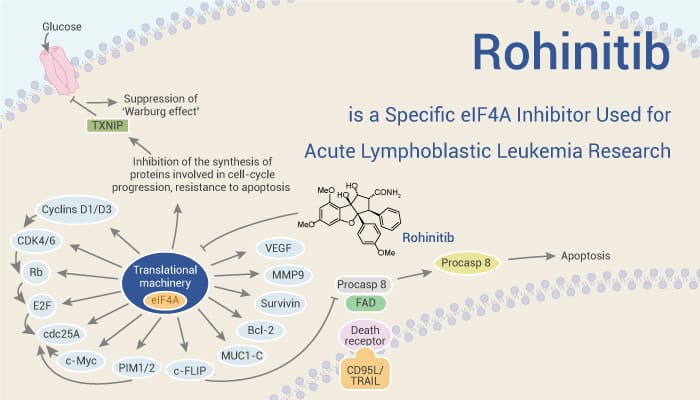eIF4A is an enzymatic core of the eIF4F complex and an indispensable effector of the mTORC1 pathway. In the first place, eIF4A is a popular target for cancer treatments. Due to the inhibitory effect to translation initiation, eIF4A represses the oncogenic activation of HSF1. Moreover, HSF1 is a factor that maintains the growth and survival of cancer cells. Of all the cancers, acute myeloid leukemia (AML) gets a lot of attention. AML is an aggressive hematological cancer. That’s because of the uncontrolled proliferation of differentiation-blocked myeloid cells. A promising target in AML is the mammalian target of rapamycin complex 1 (mTORC1). Therefore, eIF4A has become a promising target to inhibit the mTORC1 signaling pathway. What’s more, eIF4A promotes T-cell acute lymphoblastic leukemia development and is necessary for leukemia maintenance. Most important of all, eIF4A brings hope for the cure of AML. Here, we will introduce a specific eIF4A inhibitor, Rohinitib.
Rohinitib is a potent and specific eIF4A inhibitor that induces apoptosis of AML cell lines.

Rohinitib is selected among 300000 compounds. It’s worth noting that Rohinitib is the most potent inhibitor of HSF1-driven transcription. In addition, Rohinitib abrogates malignancy-associated HSF1-DNA binding.
Based on the results of in vitro experiments, Rohinitib induces cell apoptosis of AML cell lines. Bsides, primary AML cells show sensibility to Rohinitib. Last but not least, Rohinitib shows anti-AML effects in AML xenograft mouse models. So this result further proves the efficacy of Rohinitib in the cure of AML.
To sum up, Rohinitib is a potent and specific eIF4A inhibitor. Rohinitib can be used for the research of AML.
References:
[1] Fooks K, et al. J Exp Clin Cancer Res. 2022 Dec 9;41(1):340.
[2] Nishida Y, et al. Leukemia. 2021 Sep;35(9):2469-2481.